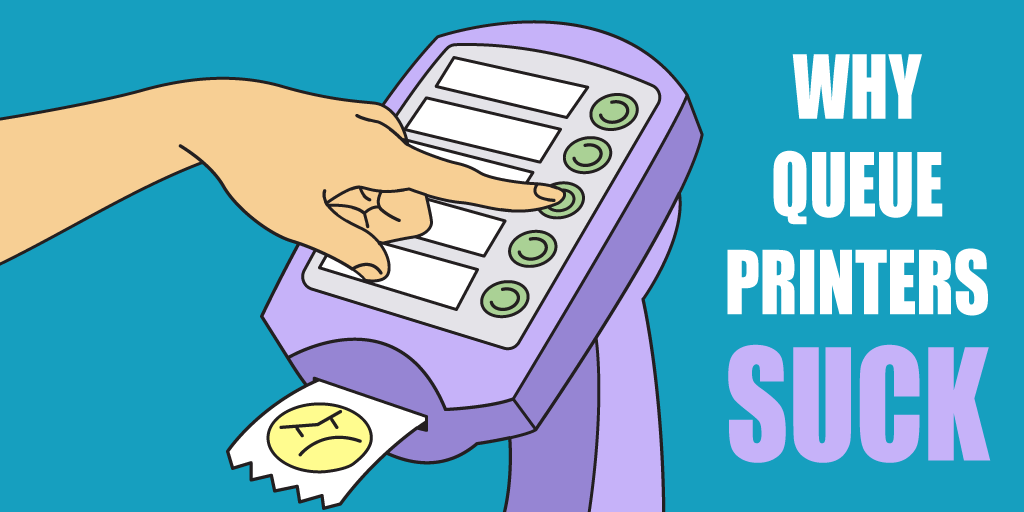Have you ever heard the saying “If you want something done right, do it yourself”? That’s always a reassuring sentiment to hear, but it’s not always such a clear-cut case.
When businesses confront the need to employ a queue management system, the first question on many executives’ mind is, “Why should we get a queuing system built by someone else? Why can’t we create one ourselves?”
The temptation to ditch QMS providers and build your own queuing system is immense, but the downsides far outweigh the possible advantages. To better illustrate this point, we will go over 3 main concerns of using an in-house queue management system, and then show how Qminder handles the same issue.
(And yes, you’re reading this on the official Qminder blog, so you naturally expect bias. But there’s nothing subjective when it comes to high-quality queuing systems!)
Okay. Ready, set, let’s go!
Concern #1: Maintenance

When they said “Build it, and they will come”, they weren’t talking about customers. They were talking about unexpected bills coming your way.
Let’s assume you’ve built a queue system the way you wanted. You didn’t cut any corners and yet are still within a budget (that’s how you know this is an imaginary situation).
But, what now?
Every piece of software, without exception, needs maintenance; the only difference being the actual amount of maintenance costs.
The analogy that first comes to mind is a car. If you’re not a fan of finding yourself in a broken-down vehicle in the middle of a desert, you need to constantly check .
Corrective maintenance (fixing bugs)
Adaptive maintenance (updating features)
Perfective maintenance (improving performance)
Enhancements
That is to say nothing about hosting fees (infrastructure, storage, bandwidth, etc.) and software licenses.
Depending on which estimation model you trust, maintenance constitutes from 40% to 90% of development cost. It’s not just the act of upgrading and tinkering with the product; it’s also hiring and paying salary to people responsible for that.
A supposed one-time fee becomes a regular drain on your wallet.
How Qminder handles it:
Most of the maintenance magic is happening off screen. On your end, there's next to no maintenance to be done. On our end, we ensure that your customer management goes without a hitch.
Qminder offers a subscription-based pricing model, which includes regular updates, fixes and improvements. Even training and onboarding costs are negligible, as Qminder provides a product walkthrough and online support.
When it comes to quality, there's no such thing as a one-time fee, but when put next to each other for comparison, Qminder is clearly better an in-house queuing system.
Concern #2: Privacy

Getting worried about security isn’t simply prevalent — it’s often encouraged. Identity theft is a major cause for heartburn among customers.
With an in-house queuing system, these concerns become prevalent. Can you ensure that the customer data that your system is handling is stored in a secure way? Which channels do you use to safely manage sensitive information?
Again, there is the matter of updates, as no privacy policy stays the same. The regulations keep improving and evolving all the time, and keeping up with them would mean extra expenditures on your part.
This is especially true for healthcare facilities which need to comply with HIPAA, both in terms of its own digital technologies as well as tools provided by third parties. Mishandling of patient data is a huge subject in the industry, and one wrong step may spell financial doom.
How Qminder handles it:
Privacy is in Qminder’s very DNA. (That’s not a joke; we’ve got a 23andMe kit to prove it!)
Like Netflix, Atlassian, Kellogg’s and Time Inc. before us, we are using Amazon Web Services (AWS) to store sensitive data. The data handled by Qminder is backed up daily, then encrypted and stored in S3.
Databases are accessible only through the Qminder web servers using an encrypted communication channel. For user authentication, we provide optional single sign-on (SSO).
We also use encrypted communications (HTTPS) on all web resources as well as extra strong password encryption algorithms.
Just like the product itself, security isn’t a “one-off thing” that you achieve and put aside. Privacy policies are constantly updated, and Qminder takes great pains to comply with the ever-changing privacy regulations.
Concern #3: Integration

Lastly, there's the matter of integration. It's the 21st century, and no tool exists in isolation anymore. Every app, program and device is (ideally) connected to and cooperate with each other. Independent components working together as a whole is what software integration is about.
The failure to integrate means:
Inefficient data management
Lowered productivity
No real-time visibility
Raised costs
Now, why does a queuing system need to be integrated with other tools? Because, as it helps capture valuable customer data, QMS needs to pass this data on to data-processing points. Name, reason for visit, history of visits, contact information — this is all that can be used in later customer interactions.
In case of an in-house queuing system, integration comes with extra costs. This is, again, something that budgeting needs to account for, and with every new piece of software added to the company's roster of equipment, the queuing system needs to be updated and adapted.
How Qminder handles it:
Qminder provides RESTful API for integrating your existing systems. This allows Qminder to communicate with other tools and platforms. Qminder can be integrated with your team's existing tech stack right out of the box.
Never lose a customer due to a missing integration and unsynced apps. Pre-built integrations help you remain competitive and take better advantage of your available technologies.
The sheer number of useful platforms and applications is growing at a rapid pace, and it can be difficult to keep up. For that reason, it is important that your choose a vendor that provides a system with powerful integration capabilities.
To sum up, why you should go for Qminder instead of attempting to build your own queuing system:
It's cheaper
It's faster
It's safer
It's more flexible
Do we need to add anything more? Try Qminder for free for 14 days, and see the benefits with your own eyes.






